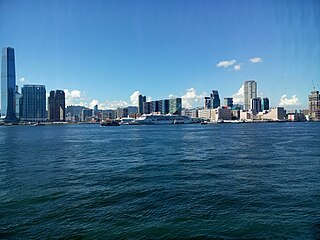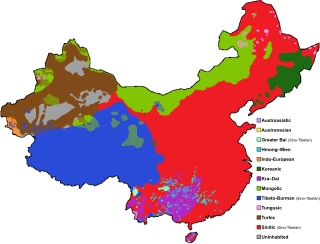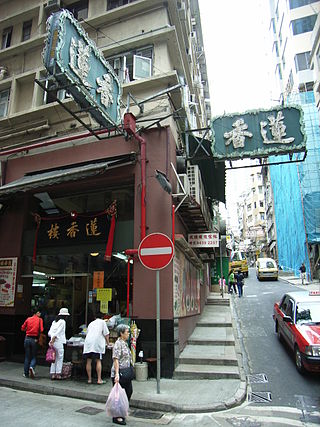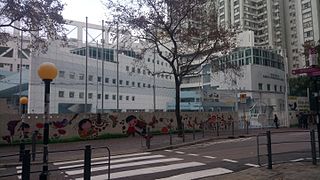
Demographic features of the population of Hong Kong include population density, ethnicity, education level, the health of the populace, religious affiliations, and other aspects.

Hong Kong Island is an island in the southern part of Hong Kong. The island, known originally and on road signs simply as "Hong Kong", had a population of 1,289,500 and a population density of 16,390 per square kilometre (42,400/sq mi), as of 2023. It is the second largest island in Hong Kong, with the largest being Lantau Island. Hong Kong Island forms one of the three areas of Hong Kong, with the other two being Kowloon and the New Territories.

Kowloon is an urban area in Hong Kong comprising the Kowloon Peninsula and New Kowloon. It has a population of 2,019,533 and a population density of 43,033/km2 (111,450/sq mi) in 2006. It is one of the three areas of Hong Kong, along with Hong Kong Island and the New Territories. It is the smallest, second most populous and most densely populated of the divisions.

There are several hundred languages in China. The predominant language is Standard Chinese, which is based on Beijingese, but there are hundreds of related Chinese languages, collectively known as Hanyu, that are spoken by 92% of the population. The Chinese languages are typically divided into seven major language groups, and their study is a distinct academic discipline. They differ as much from each other morphologically and phonetically as do English, German and Danish, but meanwhile share the same writing system (Hanzi) and are mutually intelligible in written form. There are in addition approximately 300 minority languages spoken by the remaining 8% of the population of China. The ones with greatest state support are Mongolian, Tibetan, Uyghur and Zhuang.

Kau Sai Chau is an island located off the coast of Sai Kung Peninsula, Hong Kong, with an area of 6.70 km2, making it the 6th largest island of Hong Kong. It is under the administration of Sai Kung District.
Gweilo or gwailou is a common Cantonese slang term for Westerners. In the absence of modifiers, it refers to white people and has a history of racially deprecatory and pejorative use. Cantonese speakers frequently use gwailou to refer to Westerners in general use, in a non-derogatory context, although whether this type of usage is offensive is disputed by both Cantonese and Westerners.

Hong Kong cuisine is mainly influenced by Cantonese cuisine, European cuisines and non-Cantonese Chinese cuisines, as well as Japanese, Korean and Southeast Asian cuisines, due to Hong Kong's past as a British colony and a long history of being an international port of commerce. Complex combinations and international gourmet expertise have given Hong Kong the labels of "Gourmet Paradise" and "World's Fair of Food".

During the British colonial era, English was the sole official language until 1978. Today, the Basic Law of Hong Kong states that English and Chinese are the two official languages of Hong Kong. All roads and government signs are bilingual, and both languages are used in academia, business and the courts, as well as in most government materials today.
South Asians are part of the Hong Kong society. As of the 2021 by-census, there were at least 101,969 persons of South Asian descent in Hong Kong. Many trace their roots in Hong Kong as far back as when the Indian subcontinent was still under British colonial rule and as a legacy of the British Empire, their nationality issues remain largely unsettled. However, recently an increasing number of them have acquired Chinese nationality.

Cài is a Chinese-language surname that derives from the name of the ancient Cai state. In 2019 it was the 38th most common surname in China, but the 9th most common in Taiwan, where it is usually romanized as "Tsai", "Tsay", or "Chai" and the 8th most common in Singapore, where it is usually romanized as "Chua", which is based on its Teochew and Hokkien pronunciation. Koreans use Chinese-derived family names and in Korean, Cai is 채 in Hangul, "Chae" in Revised Romanization, It is also a common name in Hong Kong where it is romanized as "Choy", "Choi" or "Tsoi". In Macau, it is spelled as "Choi". In Malaysia, it is romanized as "Choi" from the Cantonese pronunciation, and "Chua" or "Chuah" from the Hokkien or Teochew pronunciation. It is romanized in the Philippines as "Chua" or "Chuah", and in Thailand as "Chuo" (ฉั่ว). Moreover, it is also romanized in Cambodia as either "Chhay" or "Chhor" among people of full Chinese descent living in Cambodia and as “Tjhai”, "Tjoa" or "Chua" in Indonesia.

The Korean International School of Hong Kong is an international school located in Lei King Wan, Sai Wan Ho, Hong Kong. It is located near Grand Promenade and the Tai Koo Shing area, which are home to a large number of Hong Kong's Korean families. The international section was founded in 1994.

Japanese people in Hong Kong consist primarily of expatriate business people and their families, along with a smaller number of single women. Their numbers are smaller when compared to the sizeable presence of American, British, and Canadian expatriates. As of 2010, 21,518 Japanese people had registered as residents of Hong Kong with the Japanese consulate there. Hong Kong also remains a popular destination for Japanese tourists on their way to Mainland China; in 2004, the Japanese consulate reported the arrival of more than one million Japanese tourists.

Thais in Hong Kong form one of the smaller populations of ethnic minorities in Hong Kong, and a minor portion of the worldwide Thai diaspora.
Hongkongers, Hong Kongers, Hong Kongese, Hongkongese, Hong Kong citizens and Hong Kong people are demonyms that refer to a resident of Hong Kong, although they may also refer to others who were born and/or raised in the territory.

The Central and Western District located on northwestern part of Hong Kong Island is one of the 18 administrative districts of Hong Kong. It had a population of 243,266 in 2016. The district has the most educated residents with the second highest income and the third lowest population due to its relatively small size.
There is a moderately medium sized ethnic minority population of Nepalese people in Hong Kong, forming roughly 4% of the total ethnic minorities population. They primarily came to this territory as part of the Gurkha brigade of the British Army in 1960s. After the handover in 1997, their siblings were granted rights of abode in Hong Kong. Hence, majority of the Nepali population of Hong Kong are the children and grandchildren of Gurkha soldiers.
Hong Kong Canadians are Canadians who were born or raised in Hong Kong, hold permanent residency in Hong Kong, or trace their ancestry back to Hong Kong. In Canada, the majority of Hong Kong Canadians reside in the metropolitan areas of Toronto and Vancouver. Many Hong Kong Canadians continue to maintain their status as Hong Kong permanent residents.
According to the Census and Statistics Department of Hong Kong, there were approximately 5 thousand Koreans in 2006, of which 94.4% were usual residents while mobile residents occupied 5.6%. Korean formed one minority group in Hong Kong, constituting 1.4% out of the whole ethnic minority’s population. There were around 2000 Korean immigrant individuals who were Christians.
Pakistanis in Hong Kong are an ethnic minority in Hong Kong. According to Home Affairs Department, there are 24,385 Pakistani people live in Hong Kong constituting 4% of the population based on the 2021 census. According to the 2016 Official Census this population was then 18,094. In the 2011 census, 17,253 people were Pakistani nationals, and the number decreased to 15,234 in the 2016 census

Nicholas Edward Choi is a Hong Kong foil fencer.














